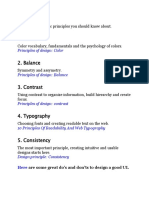0% found this document useful (0 votes)
12 views8 pagesIntroduction To UIUX Design
UI/UX design is essential for enhancing user interaction with digital products, focusing on user satisfaction, conversion rates, and brand loyalty. Key principles include visual hierarchy, consistency, user-centered design, and accessibility, with methods for research and prototyping to ensure effective implementation. The field is evolving, emphasizing responsive and mobile-first design while adapting to future trends like AI and VR/AR.
Uploaded by
smilyssk7Copyright
© © All Rights Reserved
We take content rights seriously. If you suspect this is your content, claim it here.
Available Formats
Download as PDF, TXT or read online on Scribd
0% found this document useful (0 votes)
12 views8 pagesIntroduction To UIUX Design
UI/UX design is essential for enhancing user interaction with digital products, focusing on user satisfaction, conversion rates, and brand loyalty. Key principles include visual hierarchy, consistency, user-centered design, and accessibility, with methods for research and prototyping to ensure effective implementation. The field is evolving, emphasizing responsive and mobile-first design while adapting to future trends like AI and VR/AR.
Uploaded by
smilyssk7Copyright
© © All Rights Reserved
We take content rights seriously. If you suspect this is your content, claim it here.
Available Formats
Download as PDF, TXT or read online on Scribd
/ 8























































































